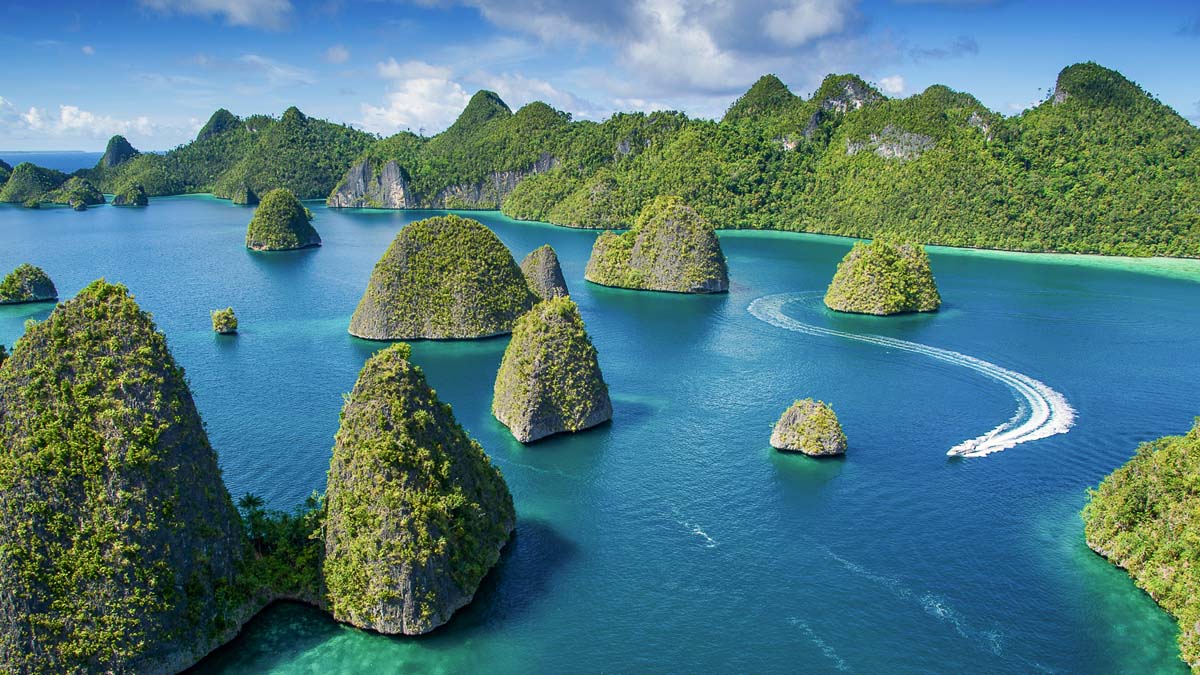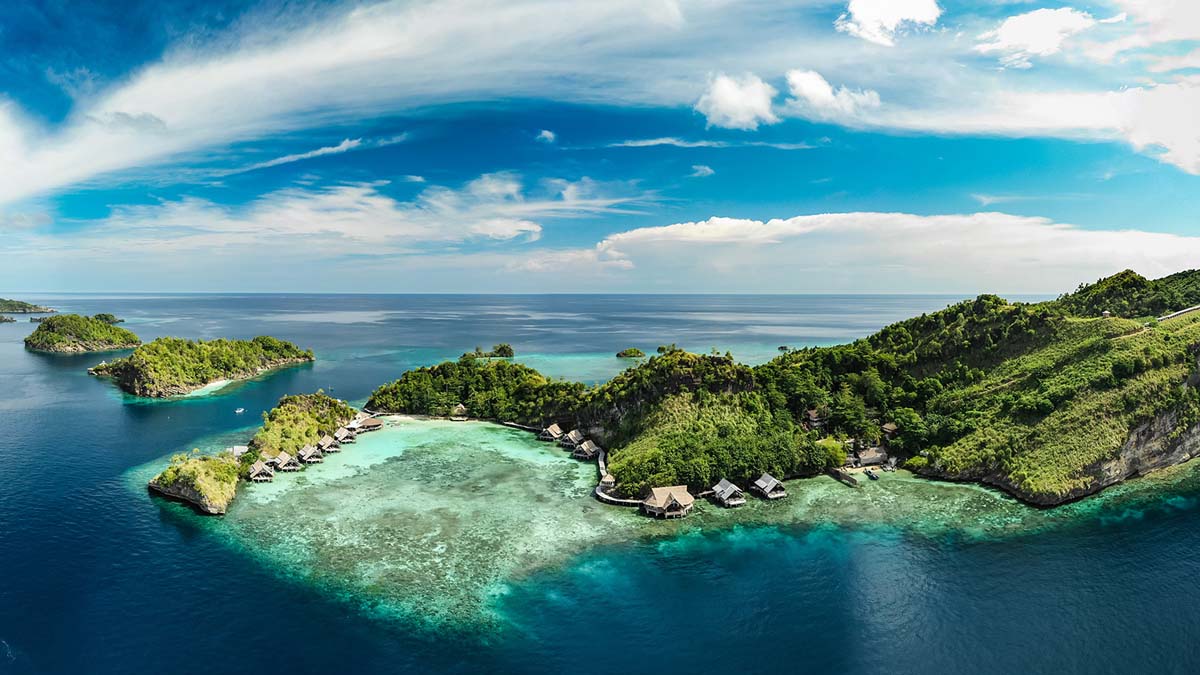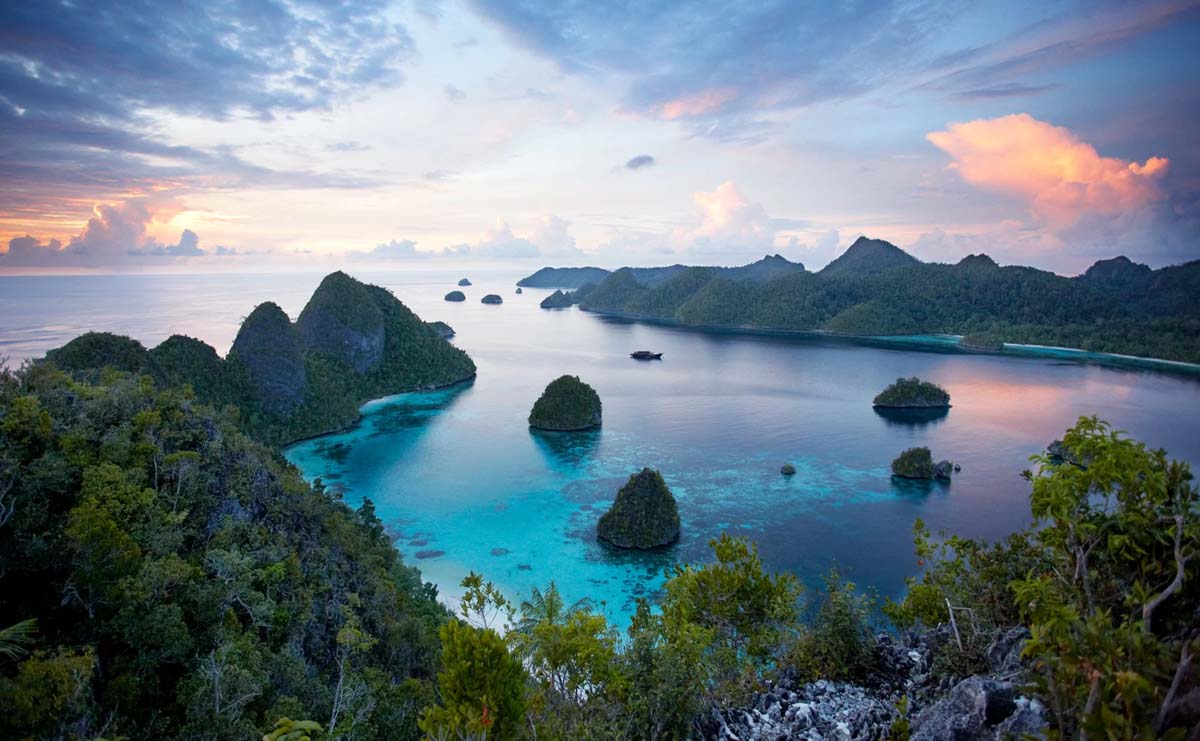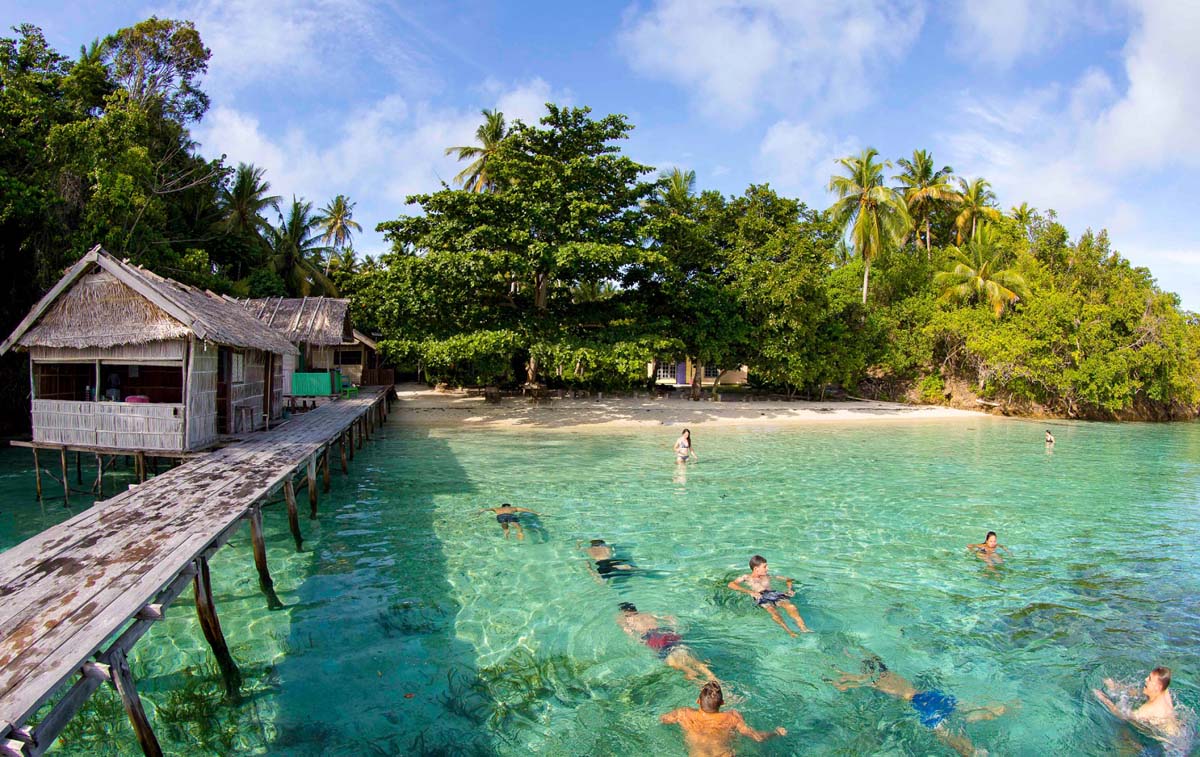



















Raja Ampat, or the Four Kings, is an archipelago located off the northwest tip of Bird’s Head Peninsula on the island of New Guinea, in Indonesia‘s West Papua province. It comprises over 1,500 small islands, cays, and shoals surrounding the four main islands of Misool, Salawati, Batanta, and Waigeo, and the smaller island of Kofiau.
The Raja Ampat archipelago straddles the Equator and forms part of Coral Triangle which contains the richest marine biodiversity on earth.
Administratively, the archipelago is part of the province of West Papua. Most of the islands constitute the Raja Ampat Regency, which was separated out from Sorong Regency in 2004. The regency encompasses around 70,000 square kilometres (27,000 sq mi) of land and sea, of which 8,034.44 km2 constitutes the land area and has a population of 64,141 at the 2020 Census.[2] This excludes the southern half of Salawati Island, which is not part of this regency but instead constitutes the Salawati Selatan and Salawati Tengah Districts of Sorong Regency
The name of Raja Ampat (Raja means king, and empat means four) comes from local mythology that tells of a woman who finds seven eggs. Four of the seven hatch and become kings who occupy four of Raja Ampat’s biggest islands whilst the other three become a ghost, a woman, and a stone.
The first recorded sighting and landing by Europeans of the Ampat Islands was by the Portuguese navigator Jorge de Menezes and his crew in 1526, en route from Biak, the Bird’s Head Peninsula, and Waigeo, to Halmahera (Ternate).
Islam first arrived in the Raja Ampat Islands in the 15th century due to political and economic contacts with the Bacan Sultanate.[3] During the 16th and 17th centuries, the Maluku-based Sultante of Tidore had close economic and political ties with the islands especially with Gurabesi.[3][4] During this period, Islam became firmly established and local chiefs had begun adopting Islam.[4]
As a consequence of these ties, Raja Ampat was considered a part of the Sultanate of Tidore. After the Dutch invaded Maluku, it was claimed by the Netherlands.
The English explorer William Dampier gave his name to Dampier Strait, which separates Batanta island from Waigeo island. To the east, there is a strait that separates Batanta from Salawati. In 1759 Captain William Wilson sailing in the East Indiaman Pitt navigated these waters and named a strait the ‘Pitt strait’, after his vessel; this was probably the channel between Batanta and Salawati.
The islands have a tropical climate, with temperatures ranging from 20 to 33 °C (68 to 91 °F).[5]
Water temperature in North Raja Ampat ranges from 28 to 30 °C (82 to 86 °F), while in the South in Misool, it ranges from 26 to 28 °C (79 to 82 °F) (Water temperature chart in Misog ol).
The islands are part of the Vogelkop-Aru lowland rain forests ecoregion.[6] The rain forests that covers the islands is the natural habitat of many species of birds, mammals, reptiles and insects. Two species of bird-of-paradise, the red bird-of-paradise (Paradisaea rubra) and Wilson’s bird-of-paradise (Diphyllodes respublica), are endemic to the islands of Waigeo, Gam, and Batanta.[7]
The recently discovered palm tree Wallaceodoxa raja-ampat is endemic to the Raja Ampat Islands.[8]
Raja Ampat is considered the global center of tropical marine bio-diversity and is referred to as The Crown Jewel of the Bird’s Head Seascape, which also includes Cenderawasih Bay and Triton Bay. The region contains more than 600 species of hard corals, equaling about 75 percent of known species globally, and more than 1,700 species of reef fish – including on both shallow [9] and mesophotic reefs.[10] Compared to similar-sized ecosystems elsewhere in the world, this makes Raja Ampat’s biodiversity the richest in the world.[11] Endangered and rare marine mammals such as Dugongs, whales (such as blue or/and pygmy blue, bryde’s, less known omura’s,[12][13][14] sperm), dolphins, and orcas occur there.[15][16][17]
In the northeast region of Waigeo island, local villagers have been involved in turtle conservation initiatives by protecting nests or relocating eggs of leatherback, olive ridley and hawksbill turtles. Their works are supported by local government, and NGOs.[18]
Raja Ampat Marine Recreation Park was designated in 2009. It is composed of four marine areas – the waters around northern Salawati, Batanta, and southwestern Waigeo, Mayalibit Bay in central Waigeo, the waters southeast of Misool, and waters around the Sembilan Islands north of Misool and west of Salawati.[19]
The oceanic natural resources around Raja Ampat give it significant potential as a tourist area. Many sources[which?] place Raja Ampat as one of their top ten most popular places for diving whilst it retains the number one ranking for underwater biodiversity.[citation needed]
According to Conservation International, marine surveys suggest that the marine life diversity in the Raja Ampat area is the highest recorded on Earth.[20] Diversity is considerably greater than any other area sampled in the Coral Triangle composed of Indonesia, Malaysia, Philippines, Papua New Guinea, Solomon Islands, and East Timor. The Coral Triangle is the heart of the world’s coral reef biodiversity, making Raja Ampat quite possibly the richest coral reef ecosystems in the world.[citation needed]
The area’s massive coral colonies along with relatively high sea surface temperatures, also suggest that its reefs may be relatively resistant to threats like coral bleaching and coral disease, which now jeopardize the survival of other coral ecosystems around the world. The Raja Ampat islands are remote and relatively undisturbed by humans.[citation needed]
The crown-of-thorns starfish eats Raja Ampat’s corals, and the destruction this causes among reefs has posed a threat to tourism. The crown-of-thorns starfish, which “can grow as big around as a trash-can lid”, has proliferated due to increasing nitrogen in the water from human waste, which in turn causes a spike in phytoplankton on which the starfish feed.[21] In 2019, local divers had begun the task of reducing starfish populations by injecting the starfish with a 10% vinegar solution; the dead starfish can then be eaten by local fish.[21]
The high marine diversity in Raja Ampat is strongly influenced by its position between the Indian and Pacific Oceans, as coral and fish larvae are more easily shared between the two oceans. Raja Ampat’s coral diversity, resilience, and role as a source for larval dispersal make it a global priority for marine protection.[citation needed]
1,508 fish species, 537 coral species (a remarkable 96% of all scleractinia recorded from Indonesia are likely to occur in these islands and 75% of all species that exist in the world[22]), and 699 mollusk species, the variety of marine life is staggering.[23] Some areas boast enormous schools of fish and regular sightings of sharks, such as wobbegongs.[citation needed]
Raja Ampat Islands have at least three ponds containing harmless jellyfish, all in the Misool area.[24]

Subscribe now and be the first to know about our special deals, promotions and offers!
Type your keyword on the search box below.
This will close in 0 seconds
